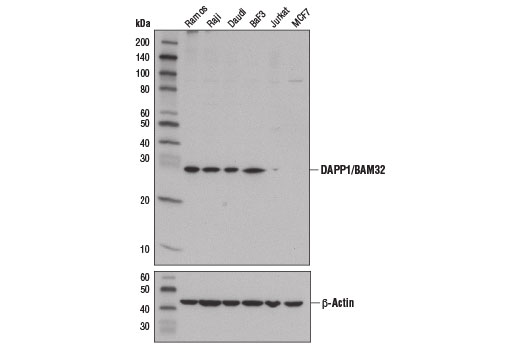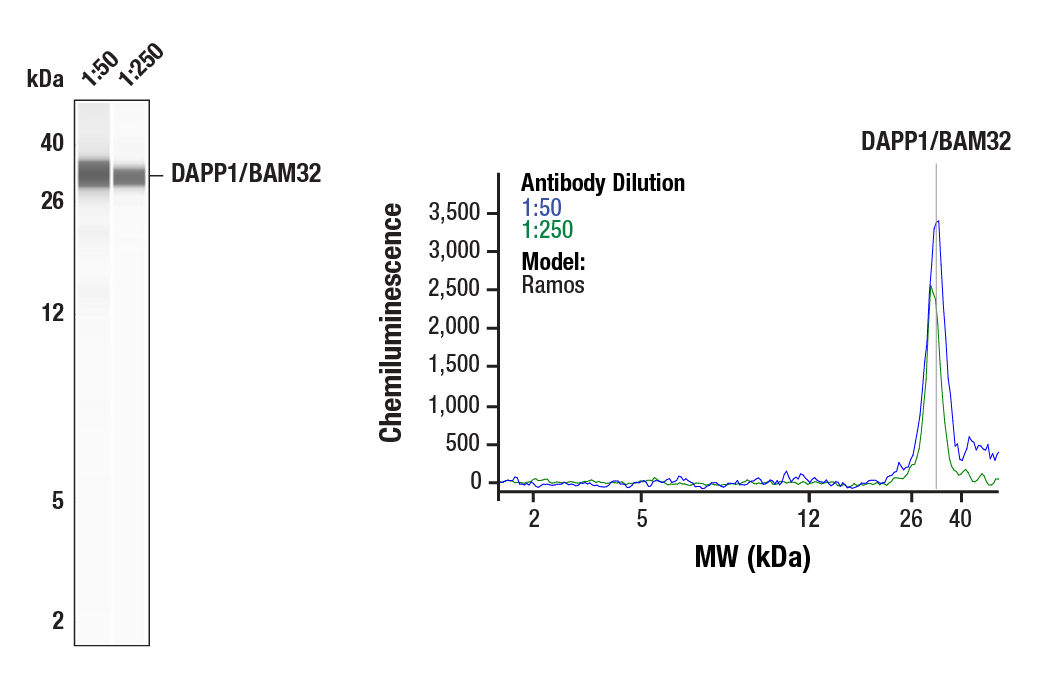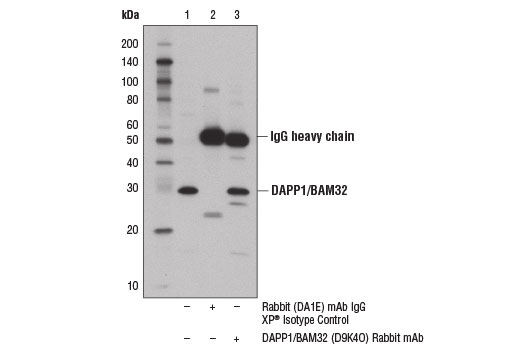WB, W-S, IP
H M
Endogenous
28
Rabbit IgG
#Q9UN19
27071
Product Information
Product Usage Information
| Application | Dilution |
|---|---|
| Western Blotting | 1:1000 |
| Simple Western™ | 1:50 - 1:250 |
| Immunoprecipitation | 1:200 |
Storage
Specificity / Sensitivity
Species Reactivity:
Human, Mouse
Source / Purification
Monoclonal antibody is produced by immunizing animals with a synthetic peptide corresponding to residues surrounding Pro159 of human DAPP1/BAM32 protein.
Background
The dual adaptor of phosphotyrosine and 3-phosphoinositides (DAPP1/BAM32) is a cytoplasmic adaptor protein that mediates the recruitment and interaction of molecules required for signal transduction downstream of the B cell receptor (BCR) (1). The DAPP1/BAM32 protein contains an amino-terminal SH2 domain and a carboxy-terminal pleckstrin homology (PH) domain that binds to PI3K-derived phosphoinositides (i.e., PIP3). Upon BCR activation, DAPP1/BAM32 is phosphorylated at specific tyrosine residues and translocated from the cytoplasm to the membrane. Research studies indicate that phosphorylation and translocation of DAPP1/BAM32 is strongly dependent upon PI3K signaling (2,3). The amino-terminal SH2 domain binds to PLCγ2 and other tyrosine-phosphorylated targets. As a result of these interactions, DAPP1/BAM32 can adjust the response to receptor activation by coordinating membrane-localized interactions among proteins of distinct signal transduction pathways (1,4). DAPP1/BAM32 is expressed most abundantly in B lymphocytes; high expression during dendritic cell (DC) maturation and localization to contact sites between DC and allogenic T cells suggest that the DAPP1/BAM32 adaptor may play a role in the activation of T cells through MHC class I-mediated signaling pathways (5).
Species Reactivity
Species reactivity is determined by testing in at least one approved application (e.g., western blot).
Western Blot Buffer
IMPORTANT: For western blots, incubate membrane with diluted primary antibody in 5% w/v nonfat dry milk, 1X TBS, 0.1% Tween® 20 at 4°C with gentle shaking, overnight.
Applications Key
WB: Western Blotting W-S: Simple Western™ IP: Immunoprecipitation
Cross-Reactivity Key
H: human M: mouse R: rat Hm: hamster Mk: monkey Vir: virus Mi: mink C: chicken Dm: D. melanogaster X: Xenopus Z: zebrafish B: bovine Dg: dog Pg: pig Sc: S. cerevisiae Ce: C. elegans Hr: horse GP: Guinea Pig Rab: rabbit All: all species expected
Trademarks and Patents
Limited Uses
Except as otherwise expressly agreed in a writing signed by a legally authorized representative of CST, the following terms apply to Products provided by CST, its affiliates or its distributors. Any Customer's terms and conditions that are in addition to, or different from, those contained herein, unless separately accepted in writing by a legally authorized representative of CST, are rejected and are of no force or effect.
Products are labeled with For Research Use Only or a similar labeling statement and have not been approved, cleared, or licensed by the FDA or other regulatory foreign or domestic entity, for any purpose. Customer shall not use any Product for any diagnostic or therapeutic purpose, or otherwise in any manner that conflicts with its labeling statement. Products sold or licensed by CST are provided for Customer as the end-user and solely for research and development uses. Any use of Product for diagnostic, prophylactic or therapeutic purposes, or any purchase of Product for resale (alone or as a component) or other commercial purpose, requires a separate license from CST. Customer shall (a) not sell, license, loan, donate or otherwise transfer or make available any Product to any third party, whether alone or in combination with other materials, or use the Products to manufacture any commercial products, (b) not copy, modify, reverse engineer, decompile, disassemble or otherwise attempt to discover the underlying structure or technology of the Products, or use the Products for the purpose of developing any products or services that would compete with CST products or services, (c) not alter or remove from the Products any trademarks, trade names, logos, patent or copyright notices or markings, (d) use the Products solely in accordance with CST Product Terms of Sale and any applicable documentation, and (e) comply with any license, terms of service or similar agreement with respect to any third party products or services used by Customer in connection with the Products.


